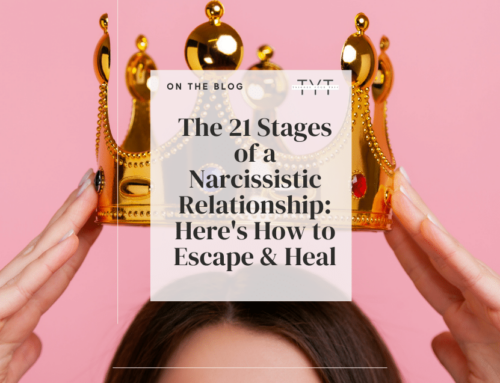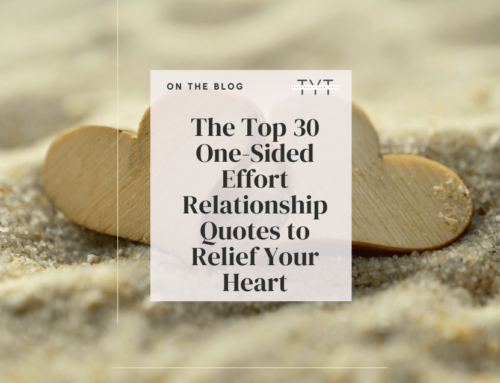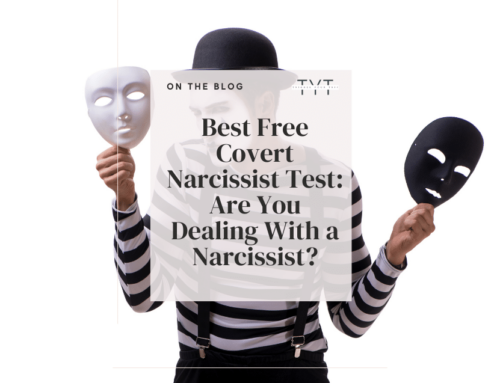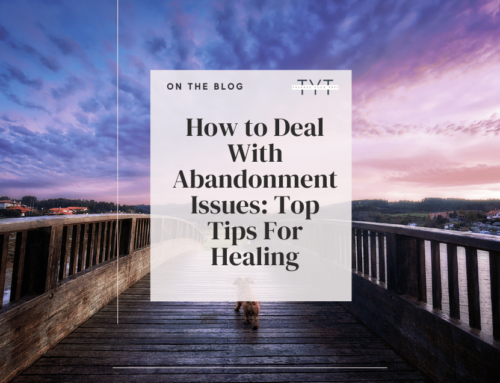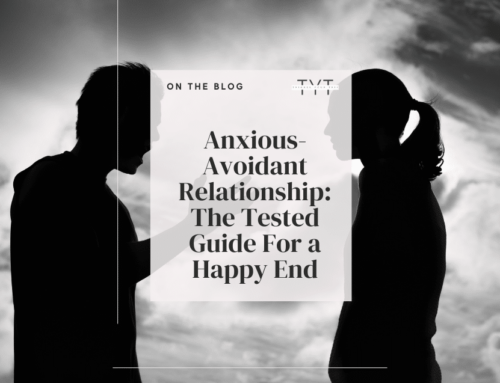As an anxiously attached person, I was shocked to find out I wasn’t entirely right to push my long-distance, avoidant partner further away with my behavior (more than 4500 actual miles already separating us.) I’ve also hated using the word “fix” regarding my relationship anxiety. Learning how to fix anxious attachment style automatically made me someone who is fundamentally wrong at her core.
However, after ignoring my attachment style for years, one day, I decided I’d had enough of it, and I was ready to do everything I could to start healing.
I knew that acknowledging my needs while assessing if a potential partner could or couldn’t fulfill them was healthy. However, being unable to stop obsessing over what my partner said and overanalyzing his behavior while assuming the worst was not.
So, shortly after I became a relationship coach, I developed a handful of strategies and self-soothing techniques to cope with these feelings of inadequacy and obsession. I knew what needed fixing, and I could address when my attachment style may have been activated or when the red flags of my partner were, what I like to call, too red to ignore.
Speaking of red flags…
Fancy knowing more? If yes, you landed in the best possible article, as I’ve written almost everything I know on anxious attachment, alongside all the techniques I used to heal my anxious attachment style and eventually marry my avoidant partner.
What Is Attachment Theory & The Various Attachment Styles?
Attachment theory
Attachment theory is a psychological framework that explains how individuals develop and sustain emotional connections with others, especially in the parent-child bond. It was first developed by John Bowlby in 1950.
According to attachment theory, early infant and childhood experiences with parents shape a person’s beliefs and expectations about relationships. In more detail, attachment theory suggests that babies are biologically programmed to seek comfort and proximity to their caregivers when they experience distress, fear, or anxiety.
Through constant interactions with a responsive and available primary caregiver, infants learn to trust that they are safe and their needs will be met, and thus, they form a secure attachment style.
However, suppose a caregiver is continually unresponsive or unpredictable in comforting the baby’s distress. In that case, the child may develop an insecure attachment style characterized by anxiety, ambivalence, or avoidance of close relationships.
These attachment styles can have long-lasting effects on a human’s adult relationships and ability to regulate emotions.
The four main attachment styles are the following:
Secure attachment style
Individuals with a secure adult attachment likely have had responsive caregivers and feel comfortable with both scenarios of intimacy and independence.
Generally, they have no problems trusting and relying on their partners and have a safe relationship where intimacy, love, and trust thrive.
Estimates vary, but research suggests that 50 to 60 percent of people have a secure attachment style and are happily bonded with their partners without the problems that the other insecure adult attachment styles would cause, such as jealousy, lack of trust, emotional withdrawal, passive aggressiveness, or fear of rejection.
A secure romantic partner will understand your insecurities and will be able to help you overcome your anxiety.
Anxious attachment style
Anxiously attached adults have a strong desire for intimacy and fear withdrawal yet often doubt their partners’ feelings while becoming overly obsessed with relationships.
Anxious attachment affects how individuals interact with their partners, as once it is activated, it is almost impossible for them to self-regulate and trust that everything is fine.
Can you recall that friend who needs constant validation, attention, and approval? Who assumes the worst if her partner doesn’t respond to her texts 24/7? Chances are, that friend is anxiously attached.
When combined with a borderline personality disorder or emotional permanence, anxious attachments can harm mental health and be the primary source of all one’s relationship problems.
Dismissive avoidant attachment style
Individuals with an avoidant attachment style fear intimacy and rely on self-sufficiency, believing they can carry on alone and don’t need anyone to feel complete or happy. Although practicing solitude and individuality is healthy, it’s essential to know that humans are social beings and are more fulfilled when happily paired in a secure relationship.
Avoidantly attached individuals unconsciously distance themselves from their partners and have difficulty forming close connections. Can you recall that ex of yours who, although they seemed to like you and enjoy your company, got cold feet whenever you expressed your feelings or lavished them with attention?
People with an avoidant attachment style have difficulty seeing an “I love you.” text on their screens. It’s one of the most terrifying things you can ask of them.
Related: How to Let Go of Someone You Almost Had? (The Best Strategies)
Fearful avoidant attachment style (or disorganized attachment style)
A fearful avoidant attachment is also an insecure attachment style characterized by a fear of intimacy and a simultaneous need for it.
Fearful avoidant attachment develops in childhood and is usually triggered by past traumatic experiences such as abandonment or abuse, leading to feelings of vulnerability and mistrust towards others.
Individuals with this fearful attachment style have trouble in their emotional world, as they may avoid close relationships or suppress their feelings and desires to avoid rejection or abandonment.
Attachment Issues And What Do They Mean
Attachment issues refer to difficulties or challenges in forming and maintaining secure emotional bonds in healthy relationships. Attachment issues typically stem from early life experiences, especially during infancy and childhood, influencing how individuals perceive and engage in relationships.
These issues can manifest in various ways, such as insecure attachment styles (e.g., anxious, avoidant, or disorganized attachment style), difficulty trusting others, needing constant reassurance, fear of abandonment or rejection, excessive dependence or hyper-independence in relationships, difficulty expressing emotions, or challenges with intimacy and closeness.
Attachment issues can impact relationships, self-esteem, emotional well-being, and overall quality of life. However, with self-awareness, understanding, and therapeutic intervention, individuals can work towards healing and developing secure attachment styles.
How Anxious Attachment Forms
Anxious attachment develops through genetic, environmental, and psychological factors.
From a genetic perspective, certain gene variations in regulating stress responses and neurochemical signaling may predispose individuals to heightened sensitivity and reactivity to social cues. In the contemporary world, this behavior could be what we’d call an overreaction.
Environmental factors, such as early childhood experiences, play a critical role; inconsistent or unpredictable caregiving, parenting issues, neglect, or trauma during infancy and early childhood can disrupt the formation of secure attachment bonds, leading to the development of an insecure attachment style, specifically anxious attachment.
Moreover, negative interpersonal relationships and experiences in later life, such as rejection or abandonment, can reinforce and exacerbate anxious attachment patterns as they resemble familiarity.
Psychologically, individuals with anxious attachments often have negative emotions, low self-esteem, and fear of abandonment, leading them to hyperactivate attachment behaviors, such as seeking reassurance or closeness, in response to perceived threats.
Most Common Characteristics of The Anxious Attachment Style
Needing extreme emotional closeness and constant reassurance
Anxiously attached individuals have a heightened need for emotional closeness, which arises from a deep-rooted fear of abandonment or rejection.
People with anxious attachment styles may have experienced inconsistent or unpredictable caregiving during their early years, leading to a lack of trust and a belief that their needs may go unmet. Seeking constant reassurance becomes a way to alleviate their anxiety and validate their worthiness of love and connection.
The fear of being abandoned or unloved drives them to seek constant emotional closeness, temporarily relieving their anxiety and reinforcing their belief that they are valued and cared for.
However, this excessive need for reassurance doesn’t heal attachment wounds, can strain relationships, and perpetuate a cycle of anxiety and seeking validation.
Read more: How Does a Narcissist React When They Can’t Control You?
Negative emotions and extreme distress because of partner’s unavailability
Someone with an anxious attachment style may have a partner who is physically or emotionally unavailable, and that triggers their attachment system, leading to heightened anxiety and distress.
Anxiously attached people interpret their partner’s unavailability as a potential rejection or loss, activating their core beliefs of unworthiness and fear of abandonment.
The unmet need for emotional connection exacerbates their anxiety, making them feel overwhelmed and desperate for reassurance and proximity.
The distress stems from their dependency on their partner for security and validation, and the perceived unavailability threatens their sense of safety and triggers their attachment-related fears.
Unable to have healthy relationships
People with anxious attachment styles may struggle to have healthy relationships due to the underlying dynamics of their anxiety disorder. Their heightened need for reassurance, fear of abandonment, and intense emotional reactions can challenge maintaining stable relationships.
Their tendency to seek extreme emotional closeness and constant validation can lead to clinginess, possessiveness, and dependence, which can overwhelm their partners and strain the relationship.
The anxious individual’s constant worry and preoccupation with the relationship’s status and their partner’s availability may also lead to a cycle of conflict and emotional volatility. These patterns can create a sense of instability and insecurity within the relationship, making it difficult for it to thrive in a healthy and mutually fulfilling manner.
Having low self-esteem
Anxiously attached individuals often have low self-esteem due to past experiences, usually in childhood. Some of them, like inconsistent caregiving or emotional neglect, can lead to a lack of secure attachment and a diminished sense of self-worth.
The worst part is that anxiously attached people may internalize feelings of inadequacy, believing they are unworthy of love and attention. The fear of abandonment and rejection can further reinforce negative self-perceptions, as they may attribute any relationship difficulties or perceived failures to personal shortcomings.
They may constantly seek external validation to compensate for their low self-esteem, relying on others’ reassurance to feel valued and secure. This reliance on external sources for validation reinforces their negative self-perceptions, creating a cycle that perpetuates low self-esteem.
Read more: 140 Top Affirmations for Self-Love Help You to Build Confidence
Frequent negative thought patterns when it comes to romantic relationships
As a result, people with an anxious attachment style are trapped in a cycle that reinforces their limiting beliefs, thinking that nobody can be trusted, all relationships are doomed and are unworthy of love and affection.
In addition, their anxious attachment style leads them to be hypervigilant for signs of rejection or abandonment, causing them to interpret ambiguous situations negatively. They may tend to magnify minor issues, catastrophize outcomes, and assume the worst-case scenario, which fuels their anxiety.
These thought patterns are driven by their deep-rooted fear of not being loved or accepted and a belief that they are inherently unworthy of secure and lasting relationships. These thoughts become automatic and ingrained, shaping their perception of themselves, their partner, and the relationship.
No wonder I was the drama queen for years in the eyes of my avoidant partner. Challenging and reframing these negative thought patterns needed a lot of effort, and it took me years to develop more balanced and positive relationship perspectives.
What Triggers Anxious Attachment Style?
Any perceived threat of rejection or abandonment can activate an anxious attachment style and lead to heightened anxiety and a strong desire for constant contact or communication.
Someone with an anxious attachment style may also excessively monitor their partner’s activities, like stalking them when they are away, counting the minutes since the last text, or becoming overly preoccupied with relationship dynamics – e.g., “Why hasn’t he told me how he’s feeling yet?”.
As mentioned, an anxious person might interpret ambiguous situations negatively, have difficulty trusting someone, and may overreact to the slightest perceived signs of disinterest or withdrawal.
These behaviors are rooted in a deep-seated fear of rejection and a strong desire for emotional security, often leading to a cycle of seeking closeness and experiencing heightened anxiety when needs are unmet, especially in an anxious-avoidant trap, where the dismissive-avoidant will pull away in intimate relationships.
The most common anxious attachment triggers are:
- Partner’s rejection, disinterest, or withdrawal
- Hot and cold behaviors, e.g., one-day sending flowers and the other not responding to texts
- Emotional distance from a partner, e.g., taking a weekend or a night for themselves
- The partner’s attachment style – in case the partner has an insecure attachment style as well
- Ghosting or unpredictable vanishing
- Partner forgets important events
- Partner doesn’t reciprocate affection or emotional needs equally
- Partner doesn’t return calls or texts in a specific time frame
Read more: Trapped in a Narcissistic Relationship Pattern? The 7 Awful Signs
Can You Heal An Anxious Attachment Style?
The good news is that the anxious attachment style, like all insecure attachment styles, can eventually heal with proper and constant effort and become a secure attachment. Here are the most common ways to heal an anxious attachment style:
- Seek professional help
- Learn all you can about your attachment style
- Increase self-awareness
- Develop self-regulation strategies for anxious behaviors
- Create a support network
- Know your needs and communicate them openly
- Build secure attachments and form secure relationships
- Focus on self-care, practice mindfulness, and find your purpose
- Challenge negative thought patterns and limiting beliefs
- Work on self-soothing techniques
As an anxiously attached person, I have tried all the above techniques, so I’m here to tell you that constant practice and combination are vital to healing your attachment wounds.
You can’t practice some of them for a few weeks and expect to have a secure attachment style suddenly. Equally, don’t be disappointed if your good old anxiously attached self surface on the first trigger because it’s almost guaranteed it will happen.
The solution lies in practicing the methods above enough to become habits so that secure responses will come naturally. So, let’s explore each one in detail and how it can help you.
-
Seek professional help
Therapy is the first and best tip on how to fix anxious attachment style, as it provides a structured and scientifically informed approach to addressing insecure attachment, offering personalized guidance, support, and tools for healing and developing more secure attachment patterns.
More specifically, your therapist can help you with Emotionally Focused Therapy (EFT) or Attachment-Based Therapy to target specific attachment-related issues and promote healing. These therapies have been extensively studied and shown to improve attachment security effectively.
In addition, a skilled therapist can create a secure and trusting therapeutic relationship, which serves as a reparative experience for individuals with anxious attachment; it works as the relationship you likely didn’t have with your primary caregiver.
The relationship with your therapist can provide a safe space to explore attachment patterns, express emotions, and develop healthier attachment strategies.
-
Learn all you can about your attachment style
Knowing where your insecure attachment style comes from is critical to make sense of past experiences, including early attachment disruptions or traumas. By exploring and understanding your early experiences, you can begin to reframe and integrate them into your narrative, fostering healing and growth.
In addition, by understanding attachment theory and the various attachment styles, you can easily spot characteristics in potential romantic partners, which is extremely useful to avoid the anxious-avoidant trap and aim for healthy relationships.
Read more: 5 Books on Attachment Theory Explain Your Obsession Over Certain People
-
Increase self-awareness and learn coping skills
Self-awareness allows individuals to recognize and understand their insecure attachment style and the underlying fears that drive their anxious attachment behaviors. By gaining this insight, they can challenge and reframe negative thought patterns and beliefs about themselves and their relationships.
In addition, your therapist or coach can teach you coping skills, such as mindfulness techniques, emotion regulation strategies, and effective communication tactics, providing you with practical tools to manage your anxiety and navigate relationships more securely.
These skills might empower you to cultivate healthier and more secure attachment patterns, fostering fulfilling and satisfying relationships based on trust, security, and mutual support.
-
Develop self-regulation strategies
Sometimes, no matter your acknowledgment that your attachment system is activated, your efforts to not act upon it will fail. That’s when self-regulation strategies come into place.
Sle-regulation strategies are beneficial when you know your anxious attachment style is playing its part and you’re about to act impulsively. So, you can use other techniques, such as deep breathing, grounding exercises, and mindfulness practices, that help you become more aware of your emotional states and, thus, replace an anxious response with a calm one.
By developing these strategies, you can reduce impulsive reactions, gain control over your emotions, and ultimately decrease your reliance on others for soothing and reassurance. Self-regulation can foster a greater sense of self-reliance and emotional stability, leading to healthier and more secure attachment patterns in relationships.
Read more: The 5 Best Crystal Candles for a Calm Self-Healing Ritual
-
Create a support network
As mentioned, anxious attachment often involves a deep-seated fear of abandonment and a strong need for reassurance and validation from others.
So, by developing a support network, you can cultivate a sense of safety and security through the presence of reliable and trustworthy individuals in your lives. This network can include friends, family, therapists, or support groups who can provide emotional guidance and understanding.
A support network allows you to share your fears and concerns, receive validation and reassurance, and gain perspective from others who can offer different viewpoints.
This support can help individuals with an anxious attachment style to feel more grounded, build self-esteem, and develop healthier patterns of relating to others based on trust and interdependence.
-
Know your needs and communicate them openly
Knowing and communicating your needs assertively will help you eliminate inappropriate partners or intimacy misfits. I wish I had practiced that skill early enough in my dating life; I wouldn’t have wasted days, months, or even years “waiting” for others to finally realize my worth and be ready for that unconditional love I secretly craved.
Some people will never be ready or suitable for you, even if you gift them a sky full of stars (thanks Coldplay, but I’m done not caring about being torn apart). So, knowing and stating your desires to your partner is essential (without pressure.) Try not to “play it cool” out of fear of driving them away. Trust me; it’s better for both of you if they are gone earlier than later.
If you’re looking for something serious, it’s good to let your date know since the beginning, long before you’re actually attached. If your different expectations make you uncomfortable, proceed to an open discussion as soon as possible. If you aren’t cool, let your partner know.
Don’t try to assume the worst; most of all, don’t second-guess yourself; your needs are yours, and some people can’t or won’t fulfill them.
Read more: Empath And Narcissist Bond: 6 Reasons Narcissists Want Empathy
-
Build secure attachments and form secure relationships
By developing secure attachments – especially in romantic relationships with secure partners, you can experience a sense of safety, trust, and stability within your relationships. Secure attachments provide a consistent source of emotional support, reliability, and responsiveness, helping you feel safe and gradually eliminating your fear of abandonment.
Secure relationships foster an environment where you can openly communicate your needs and fears, leading to greater understanding, empathy, and security.
Over time, experiencing secure relationships can help all individuals with anxious attachment styles to rewire their belief systems about relationships, build self-confidence, and develop healthier patterns of relating based on trust, intimacy, and emotional resilience.
So next time, before you eliminate someone “too dull” or “too available,” it’s mature to evaluate whether the unpredictability you crave is something you genuinely need.
-
Focus on self-care, practice mindfulness, and find your purpose
Self-care involves prioritizing one’s physical, emotional, and mental well-being, which helps to build a strong foundation for healthy relationships. By engaging in activities that bring joy and fulfillment, you can cultivate self-love, reduce anxiety, and enhance self-esteem.
Mindfulness practices, such as meditation or deep breathing, enable you to be present at the moment, observe your thoughts and emotions without judgment, and cultivate a sense of inner calm and self-awareness.
These activities will help you regulate your emotions, reduce reactivity, and approach relationships from a place of clarity and stability.
Furthermore, finding your purpose or pursuing meaningful goals can provide direction and fulfillment, fostering a stronger sense of self and reducing dependence on others for validation. You should find someone to share your meaningful journey with, not make them your boat.
By focusing on self-care, practicing mindfulness, and finding purpose, you can develop a stronger sense of self and create a more secure and fulfilling life.
Read more: Finding Your Purpose Worksheet + 10 Top Tips on Blessing It
-
Challenge negative thought patterns and limiting beliefs
I’ve purposely put that step as the last one, as hacking your subconscious mind and rewiring your brain requires extreme effort, reflection, and self-perception, and it’s almost impossible to achieve without coaching or professional guidance.
However, being able to identify and eliminate your limiting beliefs gives you, as I like to say, an almost superpower, making you feel invincible. Self-sabotaging, low self-esteem, imposter syndrome, or anxiety are almost always why people can’t reach their full potential and end up fulfilling their ill-fated self-prophecies, e.g “I won’t be married out of love but out of necessity,” “I won’t find someone good enough to have kids with,” or “nobody is ever to be trusted.”
I was in that exact position five years ago, so I promised myself to identify all my limiting beliefs and break them one by one. After reading tens of thousands of books on the subject, I created a system, which I practiced weekly, for three months straight. I was so surprised by the mindset shift that I put all this knowledge in a guide and gifted them to a few (anxious) friends of mine. The results were astonishing. That is what became session number 1 and 3 in the Spiritual Guide to Good Fortune, an affordable coaching tool I created for women like you willing to do everything to thrive and claim what they deserve. You can check it out on Amazon.
In a nutshell
In conclusion, overcoming an anxious attachment style is a journey that requires self-awareness, self-compassion, and intentional effort. By understanding the roots of your attachment style and implementing these top-tested strategies, you can make significant progress in cultivating healthier, more secure relationships.
Remember to prioritize therapy, develop a strong support network, practice self-soothing techniques, set and maintain boundaries, and engage in activities that promote self-growth and confidence.
With time and perseverance, you can heal your inner child from anxious attachment and build more fulfilling connections based on trust, security, and genuine intimacy.








